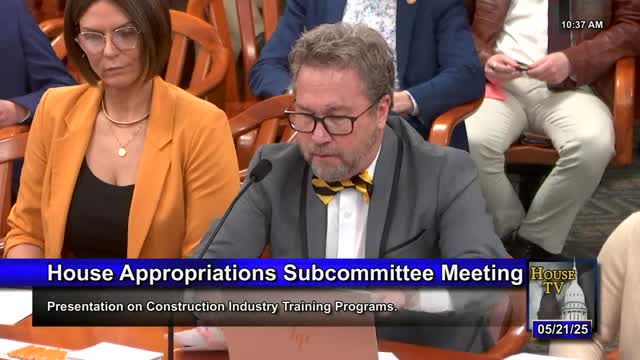Deanna Morley highlights SEMCA's hands-on training in skilled trades for Michigan students
May 21, 2025 | 2025 House Legislature MI, Michigan
This article was created by AI summarizing key points discussed. AI makes mistakes, so for full details and context, please refer to the video of the full meeting. Please report any errors so we can fix them. Report an error »

In a recent meeting of the Michigan Legislature's Subcommittee on Labor and Economic Opportunity, discussions highlighted the critical role of skilled trades education in addressing the state's labor shortage. Deanna Morley, Vice President of the Southeast Michigan Construction Academy (SEMCA), emphasized the effectiveness of their hands-on training programs, which have been instrumental in preparing students for high-wage careers in construction fields such as electrical work, welding, HVAC, and carpentry.
Morley pointed out that SEMCA has been operating for over 30 years, providing a unique "earn while you learn" model that allows students to work full-time while attending classes two nights a week. This approach not only minimizes student debt—most graduates leave without any—but also boasts an impressive employment rate of around 90%. The academy has adapted to the preferences of the younger generation, particularly Gen Z, who are increasingly opting for practical career paths over traditional four-year college degrees.
The meeting also showcased the West Michigan Construction Institute (WMCI), represented by its president, Jen Schottke. WMCI, which opened its doors in 2022, has quickly established itself as a vital resource for both high school and adult learners. Schottke shared a success story of a student named Harrison, who transitioned from aspiring accountant to a thriving carpenter through WMCI's programs, illustrating the direct connection between education and employment in the trades.
Both institutions are committed to inclusivity and accessibility, actively working to remove barriers that have historically limited participation in skilled trades. SEMCA reported that 21% of its students are people of color, and they have partnered with community organizations to broaden access to underrepresented groups. They also engage younger students through immersive field trips and interactive experiences, aiming to spark interest in construction careers early on.
The discussions underscored a growing recognition of the importance of skilled trades education in Michigan's economy. With trade school enrollment rebounding nationally, both SEMCA and WMCI are positioned to play a pivotal role in shaping the future workforce. As they continue to expand their programs and partnerships, the focus remains on creating pathways that lead to meaningful careers, ultimately benefiting the state's economy and addressing the skilled labor shortage.
Morley pointed out that SEMCA has been operating for over 30 years, providing a unique "earn while you learn" model that allows students to work full-time while attending classes two nights a week. This approach not only minimizes student debt—most graduates leave without any—but also boasts an impressive employment rate of around 90%. The academy has adapted to the preferences of the younger generation, particularly Gen Z, who are increasingly opting for practical career paths over traditional four-year college degrees.
The meeting also showcased the West Michigan Construction Institute (WMCI), represented by its president, Jen Schottke. WMCI, which opened its doors in 2022, has quickly established itself as a vital resource for both high school and adult learners. Schottke shared a success story of a student named Harrison, who transitioned from aspiring accountant to a thriving carpenter through WMCI's programs, illustrating the direct connection between education and employment in the trades.
Both institutions are committed to inclusivity and accessibility, actively working to remove barriers that have historically limited participation in skilled trades. SEMCA reported that 21% of its students are people of color, and they have partnered with community organizations to broaden access to underrepresented groups. They also engage younger students through immersive field trips and interactive experiences, aiming to spark interest in construction careers early on.
The discussions underscored a growing recognition of the importance of skilled trades education in Michigan's economy. With trade school enrollment rebounding nationally, both SEMCA and WMCI are positioned to play a pivotal role in shaping the future workforce. As they continue to expand their programs and partnerships, the focus remains on creating pathways that lead to meaningful careers, ultimately benefiting the state's economy and addressing the skilled labor shortage.
View full meeting
This article is based on a recent meeting—watch the full video and explore the complete transcript for deeper insights into the discussion.
View full meeting
